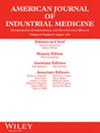Occupational stressors and mental illness in healthcare work: An intersection between gender, race, and class
Abstract
Background
Previous studies have supported the relevance of using broad and complex approaches, including multiple explanatory categories, to analyze mental disorders in the working population. This study aimed to assess the direct and indirect effects of gender, race, social class, and occupational stressors on mental health.
Methods
A cross-sectional study used a random sample of 3343 health workers. The effort–reward imbalance (ERI) scale measured occupational stressors. The World Health Organization Self-Reporting Questionnaire (SRQ-20) evaluated common mental disorders (CMDs) as outcomes. The role of gender, race/color, and class determinants (level of schooling and income) in the relationship between occupational stressors and CMD was assessed. Structural equation modeling was used to determine associations and effects.
Results
Occupational stressors were directly associated with CMD and mediated the relationship between income and CMD. Gender was directly associated with occupational stressors, income, and domestic overload. Race was associated with education and with CMD through indirect paths mediated by class indicators. Class indicators contributed to increasing exposure to occupational stressors and the occurrence of CMD.
Conclusion
The results highlight the relevance of gender, race/color, and class in understanding the unequal distribution of work stressors and mental illness in health workers.

 求助内容:
求助内容: 应助结果提醒方式:
应助结果提醒方式:


